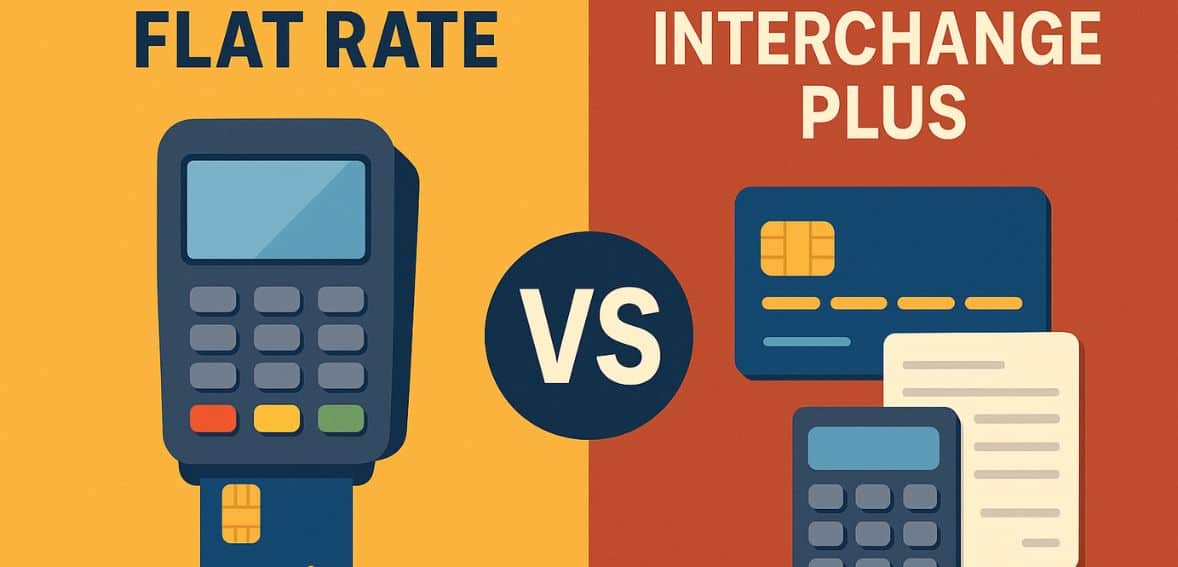
By alphacardprocess July 30, 2025
To preserve your margins, managing a business requires continuous assessment of cost structures, operational models, and vendor relationships. When it comes to payment processing, Flat rate and interchange-plus pricing is one of the most crucial decisions merchants face. Pricing models can be one of the trickiest—and most important—choices for businesses navigating the credit card processing industry.
These days, interchange-plus pricing and flat-rate pricing are two of the most popular options available to retailers. Although each model has its place, determining which one is best for your company involves more than just comparing percentages. It consists of evaluating predictability, business volume, transparency, and your overarching objectives.
Understanding the Basics: What Each Model Means
Flat-rate pricing initially appears to be the simpler choice. Regardless of the card type or issuing bank, you are given a single, fixed fee for each transaction, usually around 2.75% or 2.9% + 30 cents. Many well-known payment aggregators use this model, which is often promoted as stress-free, particularly for small businesses, though understanding the pros and cons of flat-rate pricing is essential to avoid overpaying in the long run.
On the other hand, interchange-plus pricing employs a multi-tiered strategy. The interchange rate, a base cost set by each card network (Visa, Mastercard, etc.), can change depending on the type of transaction, degree of risk, and other factors. The term “interchange plus” refers to the markup that is subsequently added by the processor. Unless you have a solid grasp of your transaction mix, this model is less predictable but tends to be more transparent.
Transparency and True Cost Breakdown

The ability to see exactly where every penny goes is one of the main benefits of interchange-plus pricing for retailers. Both the interchange fees levied by the card networks and the markup from the processor are visible. Because it facilitates improved negotiation and more transparent fee reconciliation, this transparency can result in significant savings for companies that conduct a large number of transactions.
Although they are simpler to understand, flat-rate models frequently hide the true interchange rates inside the flat fee. This implies that retailers might be paying more for inexpensive transactions. You might not realize the cost of this convenience until your monthly statement leaves you wondering where your money went.
Predictability vs. Accuracy

Flat-rate pricing excels at predictability. Startups and small enterprises frequently value knowing the precise percentage that will be subtracted from each sale. It aids in forecasting and budgeting, particularly for startups or businesses that are still developing cash flow standards. However, some variability is introduced by interchange-plus pricing. Different interchange fees apply to different types of cards, such as corporate cards, rewards cards, and debit versus credit cards.
This implies that the precise cost per transaction may differ significantly. This isn’t always a disadvantage for seasoned business owners or those who deal with expensive goods or a high volume of transactions. All that is needed is a closer examination of processing statements and possibly the help of an accountant or bookkeeper.
Scalability: What Happens As You Grow
How well a pricing model scales with your business is one factor that is often overlooked. At $5,000 per month for transactions, a flat rate might seem reasonable, but what if you’re processing $50,000 or $500,000? Even a half-percent variation in processing fees can add up to thousands of dollars a year at that level. For expanding companies, interchange-plus pricing frequently turns out to be the better long-term option.
Your ability to bargain for processor markups gets better as your volume rises. Interchange-plus gives merchant service providers the freedom to offer larger clients custom rates or volume-based discounts. However, regardless of your scale, flat-rate providers frequently lock you into their fixed pricing.
Support and Service Models

The type of support you’ll receive is frequently reflected in the pricing structure you select. Typically, flat-rate providers are tech-focused businesses that provide automated solutions and streamlined platforms. For tech-savvy companies that don’t need a lot of assistance, these can be great.
On the other hand, companies that offer interchange-plus pricing typically offer more specialized account support, thorough monthly statements, and help with chargebacks or disputes. For retailers navigating intricate sales environments or handling frequent customer service concerns, this can be a big benefit.
The interchange-plus processor structure might better suit your operational requirements if your company requires integration with more advanced tools or relies on individualized support.
Hidden Fees and Long-Term Contracts
Flat-rate providers often tout their lack of hidden fees and contracts, which is partially true. Although there might not be any monthly fees, many merchants are unaware that the flat rate may include higher overall costs. Additionally, you may lose out on interchange optimization, which reduces expenses when specific card kinds or transaction methods are utilized effectively.
More explicit fee structures, such as monthly service fees, PCI compliance fees, and possibly early termination penalties if you’re under contract, are frequently associated with interchange-plus pricing. Still, these fees can be handled more skillfully over time if they are explained and understood.
Understanding Your Customer Base
Your choice of pricing model may also depend on the type of customer you serve. If most of your customers use high-reward credit cards, you may end up overpaying with a flat rate, since the actual interchange cost on those cards is higher. Interchange-plus would at least show you the exact cost breakdown.
Alternatively, if your clientele is primarily paying with debit cards or you run a fast-casual restaurant with an average ticket size under $20, a flat-rate might end up costing you less in practice, especially when card brands apply lower fees to regulated debit cards.
Contract Flexibility and Room to Negotiate
In many cases, flat-rate pricing cannot be negotiated. You get what you see, which is useful in the beginning but restricts your options as your business expands. However, interchange-plus pricing providers are more likely to accept customized rate structures, particularly if you have a strong processing history or a larger monthly volume to offer.
With interchange-plus providers, even things like funding time and chargeback support can be negotiated. A more customized relationship with your payment partner may result from this flexibility, which is uncommon with flat-rate providers.
Technical Integration and Infrastructure

How well your pricing model integrates with your technical ecosystem is another factor to take into account. Plug-and-play integrations with mobile apps, e-commerce platforms, and point-of-sale systems are frequently provided by flat-rate providers. Busy merchants who require minimal IT problems and a quick setup can greatly benefit from that convenience.
But as your system gets more complicated, interchange-plus providers frequently offer more customization options, better reporting tools, and stronger API capabilities—especially for omnichannel companies or those with unique back-end configurations.
Looking at the Total Cost of Ownership
The simplicity of flat-rate pricing may be its initial appeal, but its long-term cost-effectiveness may be a different story. You’re probably overpaying for low-risk, low-cost transactions when you use a flat-rate. The additional percentage points can add up over time. Conversely, Interchange-plus improves the accuracy of your costs per transaction.
Because you only pay the processor’s markup on top of the actual cost to run the card, the model is more fair. When you start looking at margins, customer payment patterns, and operating expenses over months and years, that becomes a significant issue.
When to Consider Switching Models
For many businesses, starting with flat-rate pricing is ideal. However, remember how crucial it is to periodically review your payment processing configuration. It might be time to get a quote from an interchange-plus provider if your company begins routinely processing more than $10,000 to $20,000 per month. The amount of money you can save or the number of insights you can obtain from itemized reporting may surprise you.
If you’re not bound by a long-term contract, switching models doesn’t have to be a difficult process. To assist you in making an informed choice, the majority of merchant service providers are prepared to provide side-by-side comparisons based on your most recent processing statements.
Building a Strategy Around Your Choice
Your business strategy includes your payment processing fees, which are more than just line items. Pricing, profitability, and customer service are all impacted by the model selection. The simpler entry point is frequently flat-rate pricing, particularly for seasonal businesses, small storefronts, and sole proprietors.
However, interchange-plus provides flexibility for expanding companies, those with higher ticket averages, or those with a sizable card volume. Examine your current transaction volume, the types of cards your clients use, and your objectives for the upcoming year or two before making a final choice. You can match the appropriate pricing model and partner with the aid of these insights.
The Role of Customer Support In Your Pricing Model Decision

The human aspect of your payment processor, especially customer service, shouldn’t be disregarded, even though pricing models frequently concentrate on math and margins. Despite their reputation for simplicity, flat-rate providers frequently offer little or no support. More individualized services, such as dedicated account managers and quicker issue resolution, may be provided by interchange-plus providers, particularly those that serve expanding or high-volume companies.
The type of assistance you receive during a busy weekend when a chargeback dispute or terminal failure occurs can either quickly resolve the issue or cost you sales and peace of mind. Your processor’s accessibility, willingness to explain fees, and speed of response should play just as much of a role in your decision as the numbers on your statement, along with its focus on reliability and uptime to ensure smooth payment operations. Transparent pricing means little if the support behind it disappears when you need it most.
Conclusion
There is no clear winner in the debate between interchange-plus and flat-rate pricing. Rather, it’s about matching the appropriate model to your needs while remaining adaptable as they change. The decision that works best for your company now might not work as well tomorrow. Pay attention to your fees, understand what you’re getting, and collaborate with a processor who is flexible enough to accommodate your company’s expansion.
Each model has a function. The secret is realizing that payment processing is a tool that can help you control expenses, improve productivity, and maintain a healthy bottom line, not just a back-end requirement. Understanding your options gives you back control, whether you’re starting from scratch or growing quickly.